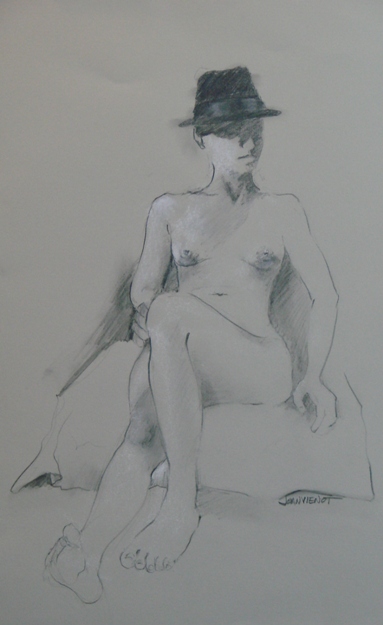 Different participants in the figure drawing sessions at Studio b. may have different expectations. Some are drawing in preparation for a painting, some for technical skill and craftsmanship, some to stretch their creativity, some to improve their ability to see, and some are attempting to complete a finished drawing.
Different participants in the figure drawing sessions at Studio b. may have different expectations. Some are drawing in preparation for a painting, some for technical skill and craftsmanship, some to stretch their creativity, some to improve their ability to see, and some are attempting to complete a finished drawing.
I don’t think there is anything that challenges me as much as working from a live model. I work towards amost all of the above goals, except that I am never preparing to paint. A completed drawing is my highest hope and my favorite art form. That does not mean that every last detail is drawn, but rather that the essential expressive nature of the pose has been captured.
That essential nature of the pose might be expressed in a 30-second gesture. The drawing at right happens to be from a 30-minute pose. The model was kneeling, but what most interested me was her upturned face and her hands behind her back. I’m happy that the pose was long enough for me to make a good effort at also capturing her likeness. Of course there are always corrections that can be made, and those are usually noticed the next day after a session. I’ve been meaning to take a camera so that I would have a reference for a correction here or there, but somehow I have never used a camera for this purpose. Maybe I’m a snooty purist, thinking that by using a photo, no longer would I be working from a live model. As a result, I have the occasional uncorrected boo-boo in my work.
It is always a temptation to begin a drawing with too much detail. The initial layout and the basic shapes need to be laid in fairly quickly. If I start with detail right off the bat, invariably I will get proportions wrong. So drawing fast is an imperative. Most of our poses at Studio b. are between 15 minutes and 45 minutes long. I remember the studio sessions when I was studying art in college, many moons ago, when we might have had the same pose for the majority of a 3-hour class. It was always a bit of an ordeal, putting the model in exactly the same position after the breaks, and frankly, the spontaneity disappeared for me. But back then, the goal was technical accuracy and craftsmanship.
At Studio b. we are fortunate to have models who are invested in our work, who ask what sort of pose we would like, who try very hard to hold difficult poses. It is an intimate experience, to be working from a model who cares about your success. I think that can lend an energy to drawing from live models that is absent when I practice from photographs. The challenge though, is that I have to draw fast, and sometimes that makes me huff and puff and sweat a little!
 |
 |
 |
Most of my images are available for purchase. Contact me if you are interested. — Joan Vienot











